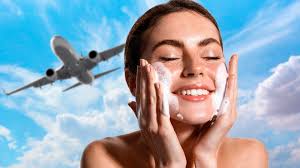
How to Hydrate Your Skin While Flying: A Comprehensive Guide to In-Flight Skincare
Flying to a new destination is always exciting—whether it’s for business or pleasure, stepping on a plane often marks the beginning of a new adventure. But for your skin, air travel is rarely as pleasant. Cabin air is notoriously dry, typically having humidity levels as low as 10–20%, compared to the comfortable 40–60% your skin is used to. That drop in humidity can quickly suck moisture from your skin, leaving it dry, tight, and stressed by the time you land.
So, what can you do to keep your skin fresh and hydrated during a flight? Below is a detailed skincare guide to help you travel without sacrificing your skin’s glow.
1. Start with Internal Hydration: Drink Water
One of the most important yet underrated ways to keep your skin hydrated while flying is also the simplest—drink plenty of water. Flying dehydrates your entire body, and your skin is the first place that dryness shows up. Aim to drink at least 2 liters of water during a long-haul flight. If you’re on a shorter flight, drink steadily and consistently—don’t wait until you feel thirsty.
Try to avoid alcohol and caffeine while flying, as these are diuretics that contribute to dehydration. Herbal teas, especially those with calming or hydrating herbs like chamomile or peppermint, can be a better alternative.
Pro Tip: Bring an empty reusable water bottle and refill it after airport security to sip on throughout the flight.
2. Facial Mists and Hydrating Sprays
Facial mists can work wonders mid-flight. These products offer an instant dose of hydration and often contain soothing ingredients like aloe vera, rose water, or hyaluronic acid. A couple of spritzes every few hours can help keep your skin from feeling tight or parched.
Look for mists that are alcohol-free and rich in humectants—ingredients that draw water into the skin.
Recommended for: All skin types, especially sensitive or dry.
3. Go Light on the Makeup (Or Ditch It Entirely)
While wearing a full face of makeup might be part of your routine, it’s best to keep it minimal while flying. Heavy foundations and powders can clog pores, especially in the dry cabin air, which makes your skin work overtime to stay balanced.
If you feel more comfortable wearing makeup, opt for a lightweight BB or CC cream, or mix your usual foundation with a hydrating moisturizer for a lighter, more breathable finish. If you can go makeup-free, your skin will thank you. You’ll land feeling fresher and more comfortable.
4. Sheet Masks and Overnight Masks
For longer flights, applying a hydrating sheet mask or overnight mask can do wonders. Sheet masks are soaked in serums full of hydrating and soothing ingredients. Use one closer to the end of the flight to maximize hydration before landing. Just be prepared to get a few looks from fellow passengers—it’s a small price to pay for glowing skin.
If you’re not into sheet masks, a leave-on overnight or sleeping mask is a great alternative. These water-based creams form a seal on the skin to lock in moisture and prevent evaporation. They are less conspicuous and just as effective.
Tip: Choose masks with ingredients like hyaluronic acid, glycerin, aloe vera, or ceramides.
5. Layer Your Skincare Before You Board
Skincare doesn’t start on the plane—it starts before you even leave the house. Prep your skin with hydrating layers that will last throughout your journey. Start with a hydrating serum (like hyaluronic acid), follow with a nourishing moisturizer, and finish with a facial oil or occlusive balm if your skin is especially dry.
Layering skincare helps trap hydration and build a protective barrier, minimizing water loss while you’re in the air.
Bonus: Bring travel-sized versions of your skincare to reapply mid-flight, especially on long-haul journeys.
6. Use Face Wipes Wisely
Face wipes can be helpful if you need to cleanse your skin mid-flight, especially if you’re removing makeup or applying a new layer of moisturizer. Choose wipes that are alcohol-free and infused with soothing ingredients like micellar water or aloe.
While convenient, don’t rely solely on wipes for long-term skincare. They’re great for freshening up but should be followed with a serum or moisturizer to restore hydration.
7. Hands Off Your Face
Airplanes are not the cleanest environments, and your hands can quickly become carriers of bacteria from tray tables, armrests, and seatbelts. Avoid touching your face unless your hands are clean. This helps reduce the risk of clogged pores and post-flight breakouts.
Use a hand sanitizer and consider carrying a small hand cream to keep your hands soft without drying them out.
8. Don’t Forget to Exfoliate—Post Flight
After you land, give your skin a chance to reset. Exfoliate gently using a face scrub or an enzyme-based exfoliant to remove any dead skin cells and airplane grime. This helps unclog pores, revives dull skin, and allows your skincare products to penetrate more effectively.
Follow exfoliation with a hydrating mask or rich moisturizer to replenish moisture and restore glow.
9. Show Your Body Some Love
Your face isn’t the only part of your skin that suffers during air travel—your body gets dry too. Once you reach your destination, take a lukewarm shower to help rehydrate your skin. Avoid hot water, which can strip your skin of natural oils.
Use a gentle body scrub to stimulate circulation and remove dead skin cells, then follow with a nourishing body lotion or oil to lock in hydration.
10. Be Mindful of Cabin Air and Temperature
While the overhead air vent helps with personal comfort, direct cold air blowing onto your face can exacerbate skin dryness. Adjust the air vent away from your face, and dress in soft, breathable layers to help regulate your temperature without relying on cabin air.
11. Smart Snacking for Skin Health
Snacks on planes tend to be salty and processed, which doesn’t help with hydration. Instead, bring your own skin-friendly snacks such as:
Cucumber slices
Watermelon cubes
Grapes
Celery sticks
Nuts with omega-3s (like walnuts or almonds)
These water-rich foods will nourish your body and skin from the inside out.
Conclusion: Land with Radiant, Hydrated Skin
Flying doesn’t have to leave your skin feeling dry, tight, or irritated. With the right hydration strategy, both internally and externally, you can step off the plane feeling refreshed and radiant. Whether it’s drinking more water, using hydrating face mists, or layering your skincare correctly, these tips will help protect your skin from the harsh effects of air travel.
So pack smart, prepare your skin, and fly with confidence—your skin will thank you.
Would you like a printable in-flight skincare checklist or packing guide for your travel bag?


